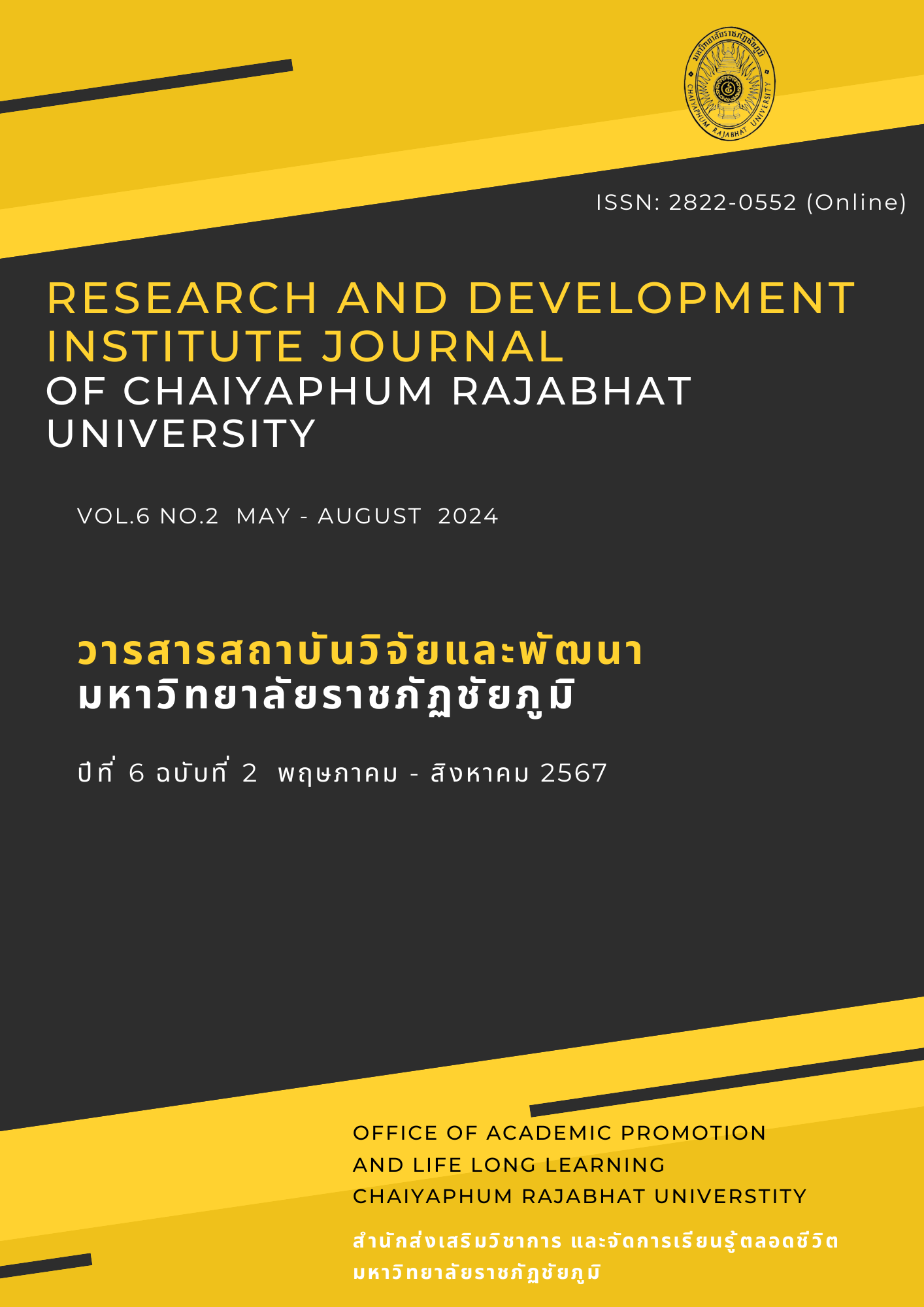THE GUIDELINES FOR PROMOTING MONK’S HEALTH IN DAN KHUN THOT DISTRICT, NAKHON RATCHASIMA PROVINCE
Main Article Content
Abstract
The purposes of this research were 1) to investigate the problems of health promotion among monks in Dan Khun Thot District, Nakhon Ratchasima Province and 2) to find ways to promote the of health monks in Dan Khun Thot District, Nakhon Ratchasima Province. Both quantitative and qualitative research methods were employed. For the quantitative research, the population included 776 monks in Dan Khun Thot District, Nakhon Ratchasima Province. The samples consisted of 254 monks. The sample size was determined according to Taro Yamane’s table using a stratified random sampling method. The research instrument was a questionnaire. Descriptive statistics, including mean, percentage, and standard deviation were employed for data analysis. As for qualitative research, the target group was 19 monks/people, who were purposively selected from monks, individuals, and related agencies. The research instrument was an interview form, and data were analyzed by content analysis.
The problems of health promotion among monks in Dan Khun Thot District, Nakhon Ratchasima Province were as follows: 1) food consumption, including consumption of food with high fat ( =4.75, S.D. =3.219), pork belly curry, pork stewed in gravy (
=4.58, S.D. =.820), and fried food (
=4.56, S.D. =.807), and 2)exercise, including walking for too long per week (
=4.77, S.D. =.929), lifting heavy objects (
= 4.60, S.D. =1.027), and walking up and down (
=4.53, S.D. =1.008).
The guidelines for promoting the health of monks in Dan Khun Thot District, Nakhon Ratchasima Province can be presented as follows. 1) In terms of food consumption, monks should choose to eat food that is beneficial and appropriate for their age. They should avoid food that is fatty, spicy, salty, sweet, or very spicy. 2) Regarding exercise, it involves walking for alms, sweeping the temple grounds, mopping the prayer hall, lifting heavy objects that are appropriate for their physical condition, and walking up and down less to maintain good health and reduce the risk of various diseases.
Article Details

This work is licensed under a Creative Commons Attribution-NonCommercial-NoDerivatives 4.0 International License.
Permission to use text, content, images, etc. of publication. Any user to read, download, copy, distribute, print, search, or link to the full texts of articles, crawl them for indexing, pass them as data to software, or use them for any other lawful purpose. But do not use it for commercial use or with the intent to benefit any business. Published under a Creative Commons Attribution-NonCommercial-NoDerivatives 4.0 International License.

This work is licensed under a Creative Commons Attribution-NonCommercial-NoDerivatives 4.0 International License
References
คูณ โทขันธ์. (2537). พระพุทธศาสนากับชีวิตประจำวัน. กรุงเทพฯ: โอเดียนสโตร์
บุญชม ศรีสะอาด. (2545). การวิจัยเบื้องต้น. กรุงเทพฯ: สุวีริยาสาส์น.
พระครูปริยัติธานสมาน. เจ้าอาวาสวัดบ้านหาร และเจ้าคณะอำเภอด่านขุนทด. (2566, พฤษภาคม 25). สัมภาษณ์
พระครูสุวิธานพัฒนบัณฑิต, ธวัลรัตน์ แดงหาญ, และ สรัญญา วภัชชวิธี. (2558). พัฒนารูปแบบการดูแลสุขภาพองค์รวมของพระสงฆ์ในจังหวัดขอนแก่น โดยเน้นการมีส่วนร่วมของเครือข่าย. วารสารสำนักงานป้องกันควบคุมโรคที่ 7 ขอนแก่น. 22(2), 117-130.
พินิจ ลาภธนานนท์. (2557) . โภชนปฎิบัติเพื่อสุขภาพพระสงฆ์. กรงเทพฯ: สถาบันวิจัยสังคม จุฬาลงกรณ์มหาวิทยาลัย.
รวีโรจน์, ศรีคำภา. (2561) . สุขภาวการณ์พัฒนารูปแบบการเสริมสร้างสุขภาวะตามแนววิธีพุทธโดยการบูรณาการสาธารณสุขเพื่อคุณภาพชีวิตที่ดีของจังหวัดพะเยา. มหาวิทยาลัยมหาจุฬาลงกรณราชวิทยาลัย วิทยาเขตแพร่. https://shorturl.at/iuGhN
ศุภลักษณ์ ธนธรรมสถิต, ปราณปรียา โคสะสุ และศิรดา ศรีโสภา. (2552). รายงานวิจัยสุขภาวะของพระภิกษุสงฆ์ในจังหวัดอุบลราชธานี. ศูนย์อนามัยที่ 7 จังหวัดอุบลราชธานี.
สุชาดา วงศ์สืบชาติ. (2554). พฤติกรรมการดูแลสุขภาพของพระสงฆ์ในกรุงเทพมหานคร. [วิทยานิพนธ์ปริญญามหาบัณฑิต] มหาวิทยาลัยมหาจุฬาลงกรณราชวิทยาลัย.
สุนันท์ แสวงทรัพย์. (2554). ปัจจัยที่มีความสัมพันธ์กับพฤติกรรมสร้างเสริมสุขภาพของพระสงฆ์ในจังหวัดนครนายก. [วิทยานิพนธ์ปริญญาดุษฎีบัณฑิต]. มหาวิทยาลัยมหาสารคาม.
Carvalho, M. J., Marques, E., & Mota, J. (2009). Training and detraining effects on functional fitness after a multicomponent training in older women. Gerontology, 55(1), 41-48.
Crichton, G. E., Bryan, J., Buckley, J., & Murphy, K. J. (2011). Dairy consumption and metabolic syndrome: a systematic review of findings and methodological issues. Obesity reviews : an official journal of the International Association for the Study of Obesity, 12(5), 190–201. https://doi.org/10.1111/j.1467-789X.2010.00837.x
Kodama, Satoru & Tanaka, Shiro & Saito, Kazumi & Shu, Miao & Sone, Yasuko & Onitake, Fumiko & Suzuki, Emiko & Shimano, Hitoshi & Yamamoto, Shigeru & Kondo, Kazuo & Ohashi, Yasuo & Yamada, Nobuhiro & Sone, Hirohito. (2007). Effect of Aerobic Exercise Training on Serum Levels of High-Density Lipoprotein Cholesterol: A Meta-analysis. Archives of internal medicine. 167(10):999–1008. https://doi.org/10.1001/archinte.167.10.999
Yamane, T. (1973). Statistics: an introductory analysis. New York: Harper & Row.

